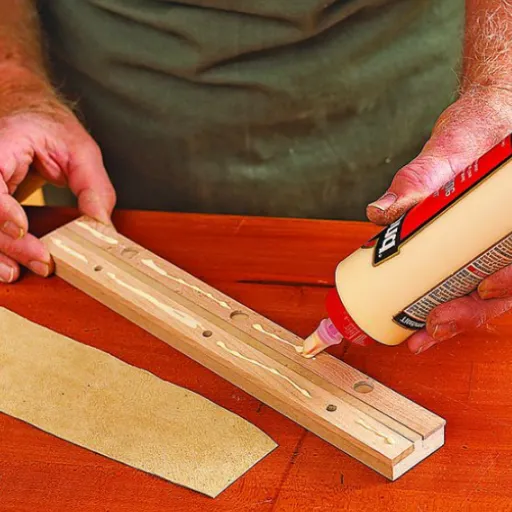When it comes to crafting, repairs, or DIY projects, materials such as leather and wood make beautiful and functional pairs. Yet, bonding these two surfaces securely and durably can sometimes become an issue. The particular type of adhesive ought to be chosen when making sure that the bond will last wear and tear from the application. Whether it’s refurbishing furniture, making custom leather decor, or a professional endeavor, selecting the right glue could be crucial. This article will discuss the best adhesives for leather-to-wood bonding, relevant considerations when deciding, and tips for achieving a strong, seamless finish.
Understanding the Basics of Glue for Leather to Wood
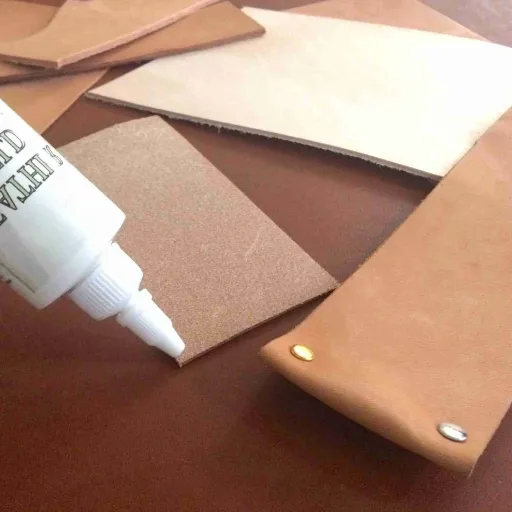
What is Wood Glue?
Wood glue is an adhesive specially formulated for bonding wood and wood-based materials. It penetrates the fibers of the wood to create a strong bond upon curing. On a working basis, it is used in woodworking projects, providing the strength needed to withstand stress and guarantee the durability of the specific application.
Wood glue is characterized by its compatibility with porous materials, such as wood and leather. Its water-based formulation makes it possible for it to seep into the finest pores of wood grain and creates a bond that is strong and reliable. This property sometimes helps it bind wood to other materials; however, surface preparation may be necessary to attain a good bond.
Wood glue is popular for its versatility, fast drying, and holding power. While wood glue is excellent for binding wood to wood, its usefulness in bonding non-wood materials such as leather depends on the surface texture and formulation of the glue. Clean surfaces nearby to adhere, apply an even coat of glue, and let it cure for enough time.
The types of adhesives suitable for leather materials
Depending on the surface to which one is bonding it, leathers require various kinds of adhesives. Contact cement, cyanoacrylate glue, and polyurethane adhesive are amongst the best adhesives available. Designed to establish strong, durable bonds with leather materials that allow their natural flexibility and movements, these special types of adhesives provide the strength and durability.
Contact cement is the most commonly used adhesive for leather. It relies upon its initial strong bond and permanent adhesion qualities. It offers the best bonding for large surfaces when an even coating has to be applied. One applies adhesive to each surface, lets it dry till it feels tacky, and then brings both surfaces to contact until they are firmly joined.
Cyanoacrylate glue is an ideal alternative for minor repairs and when precision is required. It dries fast and forms a rigid bond, thus being used to fix tears or to glue small leather components together. However, gluing areas of leather that will be under great flex is not recommended. However, polyurethane adhesive, on the other hand, stands excellent for bonding strength and provides good flexibility, making it suitable for leather-bearing projects exposed to wear and movement, such as footwear or upholstery. Remember to keep the surface clean and dry while applying the adhesive for better results.
Properties of Leather and Wood in Adhesion
Consider leather and wood as dissimilar natural resources with qualities that influence their adhesion characteristics. The leather surface is porous and somewhat stretchy, the ability to absorb adhesives and form strong bonds when adhesives meant for flexible surfaces are used. When the surface is not properly prepared, the presence of natural oils can interfere with adhesion, thus cleaning and drying become necessary before application. The second thing relating to leather is that since it bends, adhesives should not crack upon bending or movement.
On the other side, wood is more rigid and absorbent while having a fibrous structure at the same time. Its porosity allows adhesives to permeate the surface, and therefore, strong mechanical bonds are formed. Wood, however, can offer an impediment to adhesion if the chosen type is oily or resinous, say teak, in terms of surface properties. Proper preparation, which entails sanding and cleaning, is an important precondition to ensuring a secure bond on wooden surfaces. This rigidity, unlike leather, allows for adhesives of less flexibility.
Consider, then, when leather is bonded to wood, the vastly different properties must be considered. The adhesive must allow for flexibility in keeping with the movement of the leather while staying very firmly glued to the wood surface. Hence, polyurethane and contact adhesives are generally found to be effective in meeting both materials’ peculiarities. Also, proper surface preparation whereby cleaning and slight roughening of the contact areas are done ensures the resultant bond will be durable and long-lasting.
Effectiveness of Glue Leather Applications
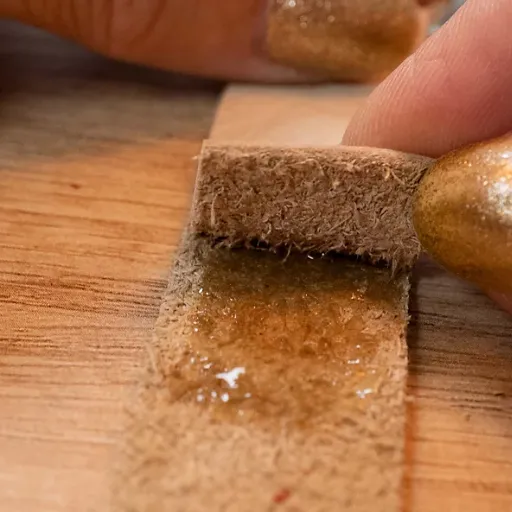
Is wood glue good for leather?
While it is possible to glue leather with wood glue, it is far from being the proper adhesive to use on this material. Wood glues are formulated for materials which are porous, like wood, hence they develop a strong bond between the surfaces of wood. Even though leather does have somewhat porous qualities, wood glue does not provide the flexibility needed to accommodate the natural movement of leather, and this would, therefore, develop brittle or weak bonding over time.
In using wood glue for leather, one should consider the limitations. The bond could lose its flexibility, especially if the leather is often bent or stretched. Also, wood glue might work rather badly on smooth or treated leather surfaces with respect to adhesives such as the ones based on contact or polyurethane, designed to glue non-porous and elastic materials like leather more efficiently.
For best results in joining leather to wood, use an adhesive formulated for use on both materials. Contact adhesives and polyurethane glues will provide stronger and more flexible and durable bonds that can stand up to movement and wear. Wood glue may work in some low-stress instances; however, for long-term durability and bonding, picking the right adhesive suited for both leather and wood would pay off.
Advantages of Using the Right Glue
If you buy the wrong glue to join leather and wood, these materials may not form the strongest bond against pressure, movement, and wear over time. On the other hand, the right glue binds the two materials in a way that is very difficult for them to be broken apart or damaged under any kind of pressure. Such kind of reliability is needed in projects that require high durability.
Also, having the correct glue will make your joint slightly flexible and keep up with performance requirements. If an inappropriate glue is selected that cannot compensate for the movement of the leather or wood, the natural movement will impede the gluing strength. This is crucial for situations where the materials undergo frequent manipulation or environmental alterations.
Finally, this adhesive concludes with a neat finish. Less mess is created, so it gives a classic look with less chance of glue failure and chance of glue being visible from the outside. With a glue that fits both leather and wood, you give your projects a professional finish that will stay with you for life.
Case Studies: Successful Leather to Wood Attachments
📌 Restoring an Antique Chair
An antique chair with a wooden frame and leather upholstery had to be restored after years of wear and tear. With adhesives chosen for that purpose, the restorers reattached the leather to the wooden frame, concentrating on ensuring a strong yet invisible bond. The adhesive remained intact and gave way only to the normal wear and tear of regular use. The restoration lends additional life to the chair while avoiding aniline fills that would have compromised its historical value and appearance.
📌 Making a Desk Pad
A craftsman created a custom wood desk pad with a leather surface for an individual client. The challenge was to bond the leather to the wooden base so that it would stay down and maintain an invisible finish. By applying an even layer of adhesive fairly thinly and allowing it to cure properly, the leather bonded as good as any glue type leather should to wood. This desk pad is therefore highly durable and aesthetically pleasing due to its ability to withstand daily use.
📌 Making Decorative Wall Panels
A designer creating decorative wall panels for a modern interior decided on leather and wood for maximum sophistication. The leather was glued onto the wooden panels to give a sleek, classy finish. Longevity was guaranteed by the sinewy application of adhesive technique, even in varying temperature and humidity conditions. Throughout time, the panels will have remained intact and visually arresting, a good testimony to the reliability of the adhesive procedure used.
These case studies show the strength and versatility depending on the proper choice and application of adhesives while bonding leather to wood. Each case highlights durability and success in their aesthetic finish, opening worlds of possibilities of this combination for a range of creative and functional endeavours.
Proper Application Methods for Attaching Leather to Wood
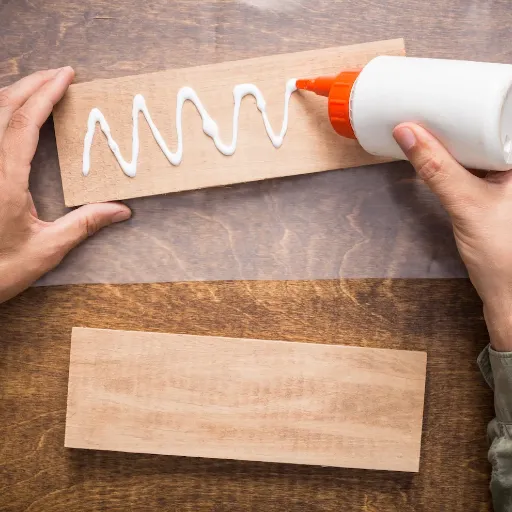
Step-by-Step Guide to Gluing Leather to Wood
- Prepare the Surfaces: Start by ensuring both the leather and wood surfaces are free of any dust, oils, or debris. Wipe the wood with a slightly damp cloth, and clean the leather using a leather cleaner or an alcohol wipe, then allow both surfaces to dry completely.
- Sand the Wood Surface (Optional): Lightly sanding the wood surface with fine-grit sandpaper will improve adhesion by creating a rougher surface for the glue to hold onto. Wipe away any dust using a dry, clean cloth after sanding.
- Apply the Adhesive: Choose an adhesive that will bond leather to wood. Apply a thin, evenly spread coat of glue on the wood surface using a brush or applicator, taking care not to use too much. Excess glue is likely to seep through the leather or cause a messy finish.
- Position the Leather: Gently place the leather onto the glued surface, aligning it carefully to avoid wrinkles or misplacement. Press down with a soft but firm hand to ensure full contact between the leather and wood.
- Clamp and Secure: Use clamps or weights to hold the materials firmly together while the glue dries. Place a layer of protection between the clamp and the leather, such as a clean cloth, to avoid leaving any marks. Leave the bonded materials undisturbed for the full curing time recommended on the adhesive packaging.
- Inspect and Finish: Once fully cured, take off the clamps and inspect the bond. Trim the excess leather at the edges if necessary for a neat finish. Giving the leather a coat of conditioner would also be ideal to keep the leather in good condition.
💡 Pro Tip: Following these steps yields a strong, durable, and aesthetically pleasing bond between leather and wood, fit for a plethora of creative and practical pursuits. Proper preparation and attention to detail are the foundations of excellent outcomes.
Tools and Materials Needed
The tools and materials for bonding leather to wood should include the basic tools and materials. These materials include leather pieces cut exactly to the shape needed, wood sanded and prepared for adhesion, and a strong adhesive for bonding leather to wood. Make sure the adhesive is flexible and can withstand wear for a longer duration.
Within reach should be scissors or a utility knife for cutting the leather, clamps for binding the leather and wood together as the adhesive sets, and a soft cloth to clean or condition the leather. Sandpaper may even be required to smooth out any rough areas on the wood surface before beginning.
Finally, with all these present, leather conditioner could be used throughout the adventure to give your finish a richer feel. Meanwhile, it may polish and nourish the leather. With such tools and materials on hand, you should be ready to establish a great bond of leather and wood for whatever your application may be.
Tips for Optimal Adhesion
- For the best adhesion between leather and wood, surface preparation is very important! Start with surfaces free from any contaminations-blocks from dust, grease, or whatever-and anything that might foul the bonding operation. Wipe them with something soft; for harder residues, use a mild cleaner, but make sure it doesn’t damage them.
- Affirm the right kind of glue for your job. Consider-at-least-a good quality glue that specifies bonding leather to wood, as this will guarantee a much firmer hold than a general-purpose one. Hence, for the finish and sturdiness of your craft, a better adhesive is desirable. Properly follow the glue manufacturer’s instructions regarding the application to include drying and curing times.
- Put even pressure on the surfaces that are glued together while waiting for the glue to dry. Clamps and weights are good for holding the surfaces together evenly so that no air pockets can get trapped between the surfaces. Follow the curing times directed by the glue manufacturer so the whole process is well done and long-lasting. Following these tips will provide you with an environmentally glued binding of leather to wood that is both strong and attractive.
Common Challenges and Pitfalls
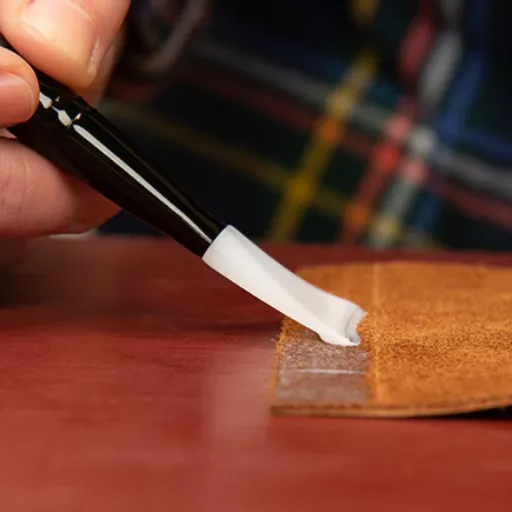
Potential Issues with Wood Glue on Leather
One major challenge associated with wood glue usage on leather is adhesion. Leather, with its flexible and porous surface, does not adhere to wood glue in the same way wood would. This difference in the material properties can actually create situations where the bond gets weaker over time or under stress. To circumvent this, one possible way to increase adhesion is by cleaning both surfaces well and giving them a slight abrasive finish. Clamping or weighing down the joined product while drying will also help enhance the bond by ensuring that the leather does not move.
The next problem occurs during drying and curing. While wood glue dries as a rigid substance, leather stays supple and capable of moving. This difference offers a disastrous promise where cracking or peeling of wood glue could be guaranteed, especially when the bonded materials are stressed or exposed to fluctuations in temperature or humidity. Providing an ample amount of time for curing and keeping the finished product in a stable environmental condition should help alleviate these issues.
Lastly, there is the issue of durability. Wear and tear or exposure to moisture may weaken the bond between leather and wood glue. Choosing the right kind of glue for the specific purpose, along with additional reinforcement methods such as sewing or tacking, etc., can ensure a longer life for the bond. By knowing about these potential problems and taking preventative measures, there can be a successful and durable bond between leather and wood.
How to Avoid Common Mistakes
One should begin by opting for the best adhesive for the process of bonding leather and wood to avoid common errors. An adhesive that is appropriate for the materials being worked upon should be chosen because all adhesives are not meant for this application. Select adhesives that have working properties in bonding leather and wood together, all while resisting moisture and wear.
Next comes preparation. Before bonding, make sure that both surfaces are clean and dry to eliminate any dirt, oils, or debris that could affect the bond provided by the adhesive. Light sanding on the wood will aid adhesion by creating a rough surface, while assuring the leather surface is free of contaminants will promote better long-term bonding strength.
Getting to the application also allow proper curing time. Apply the adhesive evenly across the surfaces being glued with excellent care given to following the manufacturer’s instructions of the adhesive. Keep the bonded pieces under pressure with clamps or weights while setting to promote adhesion and hinder slippage. Once pressure is applied, the adhesive will need ample curing time in order to build maximum strength, which becomes paramount in a working environment subjected to stress. When followed diligently, these steps will go a long way in ensuring that bonding is first blamed for less common occurrences.
Signs of Failed Adhesion
There are clear and observable signs that can help to determine the occurrence of failed adhesion. This is one of the common indications visible between the surfaces to be joined. When a bond loses contact between the two of them, or in the case where the materials start to pull apart from each other, the adhesive has either simply failed to work or done so serviceably for some time, thus wearing away.
Another sign would be when cracks appear along the line of bonding, or the adhesive surface becomes brittle. This often happens when the adhesive has been subjected to too much stress, insufficient curing, or perhaps temperature extremes, moisture, etc.: all these will make the bond go weak, ready to be snapped under pressure.
The loss of functionality serves as another definite signal of failed adhesion: when the bonded materials cannot fulfill their intended purpose due to gap-induced movement or sudden and outright failure of the bond, the adhesion is clearly compromised, and it would do well for the structure to be addressed immediately by reapplying the adhesive or by whichever means necessary to ensure the integrity and safety of the structure.
Exploring Alternative Adhesives for Leather Projects
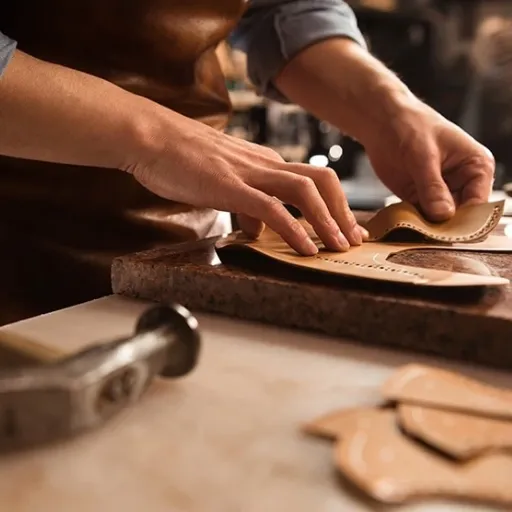
Contact Adhesive: Pros and Cons
| Advantages | Disadvantages |
|---|---|
|
Strong and instant bonding capability, making it ideal for larger leather areas requiring quick adhesion |
Difficult to make adjustments once surfaces come into contact – requires precise positioning |
|
Excellent bonding agent for non-porous surfaces, offering versatility for different types of leather |
Contains strong-smelling solvents that require proper ventilation during application |
|
Maintains proper alignment and prevents movement during the bonding process |
Potential health impacts if not used properly due to toxicity concerns |
All in all, contact adhesive for leather projects should be employed according to the technique requirements of the task. Should a fast and durable bond be needed, this would be an excellent adhesive. When an ointment with delicate adjustments is needed or a low-toxicity product is preferred, other glues may come into play. Adequate preparation, accurate application, and sound maintenance of safety rules will bring the finest results.
Specialized Leather Adhesives
Specialized leather adhesives are expected to fulfill the varying needs of leatherworking projects, including bonding that is strong yet flexible and durable. Usually, these adhesives are prepared to permit the natural flexibility of leather and the stresses that leather articles often encounter. These adhesives give perfectly smooth seams and do not allow the material to fray; for this reason, these are amongst the tools used by craftsmen and manufacturers.
Another type of specialized glue for leather is water-based glue, which is easy to use and more or less non-toxic. More suited to lighter applications, such adhesives allow you to position workpieces before setting those materials: a unique feature needed for intricate designs or projects where precision is critical. Conversely, solvent-based adhesives are the strongest adhesives and are meant for high-strength or industrial applications. They set fairly quickly and can withstand severe changes in temperature and are waterproof, thus most suitable for footwear, bags, and furniture.
When buying a leather adhesive, bear in mind the certain criteria posed by the project at hand: the weight of the leather, the type of stress it will be submitted to, and the finish desired. Surface preparation is another good friend of adhesion: clean and lightly scuff your material! Proper surface preparation will improve adhesion and a quality finish guarantee. When a given task demands us to choose the proper adhesive and use it right, we make sure that the leather items are not just strong in structure but pleasing as well.
Comparing Alternatives: Which would suit best?
When comparing adhesives for the leather industry, ensure you focus on their interrelated attributes of strength, flexibility, and ease of application. Water-based adhesives are some of the best choices because they offer a strong bond and are environmentally friendly. They are easy to apply, safe for indoor use, and are best for most leather projects where much stress is not applied to resist heavy-duty bonding.
Solvent-based adhesives provide pattern bonding of durability and remain excellent for high-stress applications or thick leather. They become stronger over time and tend to perform better under extreme conditions such as moist or heated conditions. But keep in mind: they should be used in a well-ventilated place because of their strong fumes.
Contact adhesives give another option to work with leather. Useful and firm bonding between adhesive layers upon pressing together, they are perfect for complicated patterns or projects that demand pinpoint precision. Proper surface preparations and methodical applications shall never fail to give you a tacky and durable solution while selecting the best adhesives lies upon the needs of your project.
Frequently Asked Questions (FAQ)
❓ What is the best way to use wood glue on leather?
The best way to glue leather using wood glue involves ensuring both surfaces are clean and dry. A thin, even layer of wood glue is applied to one side; then the pieces of leather are pressed together firmly. To ensure the bond is firm, use a vise to hold the pieces in place while the adhesive sets.
❓ What are some alternatives to wood glue for leather?
Alternatives to wood glue for leather could include super glue, barge cement, and spray adhesive such as 3M 77. Each option is fitting and offers its own advantages, such as quick drying time or flexibility, depending on what you need.
❓ How do I clean up my tools after using wood glue on leather?
To clean your tools after using wood glue, wipe them down with a damp cloth before the adhesive dries. If the glue is already hard or cured, you will have to scrape or sand it off. Clean tools will last longer and will prevent you from losing precision.
❓ Is yellow wood glue good for use on leather?
Yellow wood glue might work for leather, but this type of glue is essentially made for woodworking. It can form a strong bond but may not offer the same flexibility requirements that an adhesive designed for leather would, such as hide glue or barge cement.
❓ What are the considerations when choosing the best glue for leather?
When choosing for the best glue for leather, flexibility, drying time, and purpose of usage of the bonded items should be considered. Choose an adhesive that will give you a very strong bond with no discoloration and that is able to handle the movements of leather.
❓ Can I use spray adhesives on leather?
Yes, spray adhesives like 3M 77 will work fine with leather. They allow for an even coating in a short period of time, especially if you use them on big areas or something with a lot of curves. Spray adhesives should always be used in a well-ventilated place.
❓ Will wood glue discolor leather?
Wood glue may discolor leather, especially with yellow or white glue. To avoid discoloration, one may go for a crystal-clear adhesive or do a test first on a scrap piece of leather before applying on the main project.
❓ How does hide glue compare to wood glue in leatherwork?
Hide glue tends to be favored by leatherworkers for its old-world properties and reversibility. Unlike wood glues, hide glues can be reactivated with heat and moisture, which makes it a very handy adhesive for leather projects that may eventually require some adjustments.
❓ How would one best glue leather to wood?
The best method for gluing leather to wood is to use a strong adhesive such as barge cement or high-quality spray adhesive. Make sure that both surfaces are clean, then apply the glue evenly to the surface. Use a delay to apply pressure to the bond while it is curing.
References
- Best Glue for Leather to Wood: A Complete Guide – This guide discusses the suitability of various adhesives, including wood glue, for bonding leather to wood.
- Wood glue : r/Leathercraft – A discussion on the Leathercraft subreddit about the use of wood glue on leather, including its limitations and potential issues.
- Glue for leather to wood: How to achieve flawless results – A detailed guide on choosing the best adhesive for attaching leather to wood, comparing different types of glue.
- Strop: best adhesive to glue leather to wood? : r/sharpening – A Reddit thread discussing the best adhesives for bonding leather to wood, with practical advice from users.
- General Adhesive Recommendations for Leather and Wood – Another resource that highlights the pros and cons of using wood glue for leather projects.
















